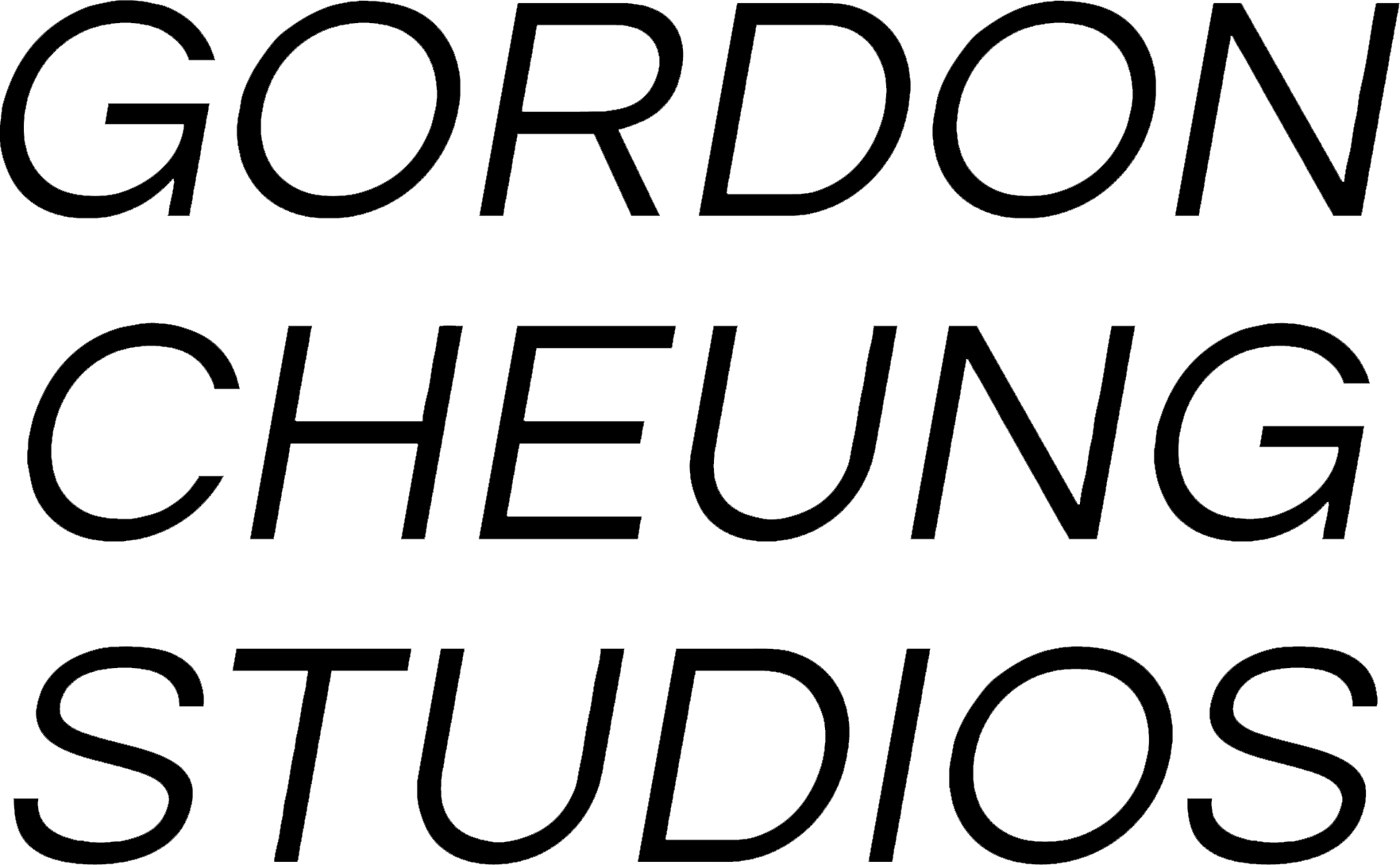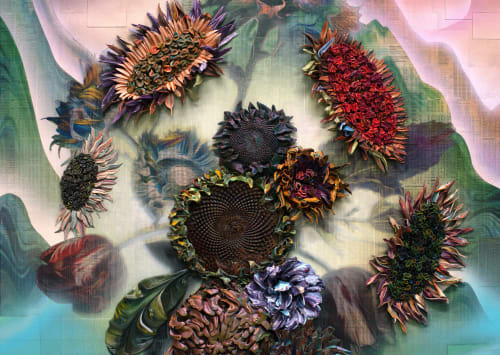Almine Rech Shanghai is honored to present the solo exhibition of the British-Chinese artist Gordon Cheung in China, "Peaceful Retreat," from September 6 to October 12, 2024. The exhibition will feature a series of recent mixed-media paintings and installations inspired by Chinese gardens, as well as ceramic sculptures specially made for this exhibition.
The artist starts with the idea of gardens to express as a microcosm, how mountains, water and plants have always been an escape for the burdens of the heart and how garden history reflects when a foreign government takes control.
Gordon Cheung has long focused on the relationship between transnational political economics and landscape painting. By combining with disruptive innovative technologies—such as AI generation and 3D printing—he explores new ways to express contemporary still life and landscape painting.
Gordon Cheung often collages fragments of the Financial Times onto canvases and window frame works. The Financial Times, which emerged at the start of the first wave of globalization, is reputed for its “Newspaper of Record”. Cheung’s final pieces reveal passages hidden beneath thick paint, expressing the undercurrents of civilizational rise and fall beyond the serene imagery. Cheung extract’s symbols of abundance woven by global trade from a detached perspective, reassembling them into psychological landscapes reflecting current affairs.
The paintings displayed in the exhibition feature distant views generated from the 1744 Qianlong Emperor’s imperial album "Forty Scenes of the Yuanmingyuan" series. The main images of vases and flowers reference Dutch Golden Age still life painting, while the foreground cityscapes are derived from Google 3D map data of the top 40 Chinese provinces by GDP, rendered into desolate lunar landscapes with spray painted sand. Combining elements from different times and regions, the realistic yet unfamiliar images create a sense of surrealism, seemingly paying homage to the "jinhuicui" art style that collages imagery of calligraphy and feasting in paintings. Art historian Nancy Berliner describes this as China's trompe-l'œil painting style, where the artist's meticulous depiction of erosion, decay, and fragmented shapes seeks to achieve a convincingly truth and deception collage effect. Cheung’s mountain contours and horizons in his paintings appear to be overexposed by photo-editing software, creating a light and dark, a stark contrast with the ground-level city views, emphasizing that paradoxically the images are joined and disjointed. This aligns with the "Jinghuidui" spirit: dramatically expressing cultural shifts through obliteration and fragmentation. Cheung juxtaposes the seasonal flower features of Dutch Golden Age paintings with AI-generated antiquated images, further detaching the works from the real-time axis to blur with the transcendent historical essence of “majestic grandeur in timelessness” pursued in Chinese literati painting.
The window frame sculpture series, Szechwan Shop 1750" and "Szechwan Shop 1850" feature patterns similar to those found in post-war Hong Kong “Tong-Lau” buildings’ "cardboard stones" (mosaic tiles, known as tessera in English). Originally imported goods, these tiles have recently been embraced by nostalgic popular culture as symbols of Hong Kong. Similarly, Sichuan cuisine, with its intense spiciness and sensory impact uncommon in Western dishes, is seen by Americans as quintessentially Orientalist and exotic. The English title "Szechwan" uses the postal-style romanization common in early 20th-century American Chinatown restaurants, highlighting the disparity in the pace of cultural transmission between the East and the West.
Debuted specifically for this solo exhibition, the work "Echo Chamber '' features 3D-printed scholar's rocks, fired in the ceramics capital of Jingdezhen. As Su Shi once said, "the ugly stone unfurls hidden beauty". The disorderly nature of bizarre rock formations is the wellspring that allows literati's boundless creativities to meander through. Since the harnessing of 3D printing technology, rapid prototyping with consumer-grade 3D printers has liberated creativity from cost and technical constraints, allowing previously unimagined forms to materialize rapidly like bamboo shoots after spring rain. "Echo Chamber" leverages the technical characteristics of 3D printing to interpret the meditative nature of literati rocks.
Cheung deftly employs the metaphor of landscape garden as a battleground for power struggles: for one, it can be the projection of a frustrated official's longing for a tranquil life in reclusion; for another, it can also be akin to the Old Summer Palace, a lavish expenditure of state resources to showcase the zenith of Qing gardening prowess and the dynasty's imperial vision of prosperity. Furthermore, it can be the garden cities established by colonial sovereigns in the Far East, where, under the pretext of sanitation, they forcefully introduce exotic flora and fauna, thereby crafting an image of the colonial rule as the God-ordained ruler. This fabricated Eden in the East is presented as the manifestation of divine will, with the "benevolent gardener” becoming the ultimate justification for colonial conquest.
The works in Peaceful Retreat convey the philosophical tenet of "not seeking perfection, content with the partial” — the paintings hover between the plane and the three-dimensional, akin to Ming-Qing wall vases; the sculptural forms reminiscent of latticed windows, where the intention is by no means "borrowing the scenery", but rather the framing of the blank wall space. The solitary scholar's rock is like a lonely peak, seemingly making room for solitary contemplation. Taking viewers on a contemplative journey, Gordon Cheung persistently upheavals and questions the inevitability of the historical narratives written by victors. Peaceful Retreat invites meditative ideas of a garden where profound fullness of emptiness evokes tranquillity with both unfinished sorrow and unbridled anticipation for the future.
Text by Zoie Yung
阿尔敏·莱希 - 上海荣幸将于2024年9月6日至2024年10月12日呈现英籍华人艺术家张逸斌 在中国的 个展《流憩》,展出一系列近年与中式园林相关的混合媒介画作及装置,以及特别为是次展览创作的陶瓷雕 塑。艺术家从写意园林出发,展现人类如何透过山水植物投射逃逸的心境,以及园林史作为外族统治的体现 形式。张逸斌 多年持续关注跨国政经和景观构成之间的关系,他通过结合绘画与破坏性创新技术——如 AI生成、3D打印,思索当代静物及风景画的崭新表现方式。
张逸斌经常将金融时报碎片拼贴在画布及漏窗作品上,然後在之上加工。诞生於第一波全球化浪潮伊始的 金融时报,以作为档案纪录报所闻名;张的最终成品,偶而透出潜藏在厚塗颜料下的零散段落,表达静谧画 面以外文明盛衰的暗湧。张逸彬尝试以冷静旁观的角度,抽取象徵全球贸易所编织的丰腴想像符号,重新组 成反映当下局势的心理景观。
展览中所展出的绘画,远景由汇入《圆明园四十景图咏》所生成,画面主体的瓷瓶花卉画参考荷兰黄金时代 静物绘画,而画面前景中的城市鸟瞰图,则是抽取中国国内生产毛额排名前四十的省份的谷歌三维地图资 讯,以颜料及喷砂渲染成月球表面的苍凉地景。由三组不同时间、地域维度结合,延拓出写实又陌生的画面 ,呈现一种无以名状的怪诞性,同时亦似是致敬以残破字画、盛宴菜渣入画的艺术风格“锦灰堆”。这个被艺 术史学家白铃安(Nancy Berliner)形容为中国的幻境画(Trompe-l'œil)绘画类型,创作者对侵蚀、破败,以 至杂形碎片的精细刻划,似是追求以假乱真的拼贴效果 —— 张逸彬画中的山脉轮廓和地平线似被修图软 体强行推高曝光值至最高,一方面与地面的鸟瞰图形成强烈的明暗对比,另一方面,高光边沿强调著画面是 堆叠而成,跟“锦灰堆”精神一脉相承:以湮灭、断裂戏剧化地表达文化的更迭。张以荷兰黄金时代绘画四时 花卉并置、颠覆季节法则的特色,与AI所生成的仿古图像互相呼应,进一步将作品从现实时间轴剥离,尝试 以西画媒介演绎中国文人画所追求超越历史表象的“无画史纵横气息”。
漏窗作品《四川店1750》及《四川店1850》的窗花花样跟香港战後唐楼常见之纸皮石(马赛克砖)相类似。纸 皮石原为舶来品,但近年被流行文化的怀旧风潮冠以香港标誌之称,犹如四川菜因著鲜见於西餐的辣度与 痛感,被美国人视为典型东方主义、异国风情中菜,当中带著误解和刻板的想像。作品英文名称Szechwan 用上上世纪初美国唐人街餐馆常见的邮政式拼音,强调中西方文化流通的速度差。
特意为上海个展创作的《回声室》3D打印文人石,於陶瓷之乡景德镇所烧製。苏轼曾道“石醜而文”,奇石的混 乱无序正是激发文人创作的灵感之源。自3D打印技术诞生後,产品设计开发的门槛大幅降低,通过民用级 别3D打印机快速打样,巧思奇想得以从成本和技术的设限中解放,过往未曾设想过的形态以雨後春笋之势 被实体化。《回声室》借助3D打印的技术特性,诠释文人石作为浮想联翩媒介的特性。
张逸斌使用园林作权力鬥争的比喻:它既可以是官场失意出世者对追求恬淡生活的投射,亦可如圆明园般 豪耗国库储备,为展示清室造园技术颠峰所作的盛世憧憬,更可以是殖民者於远东建立的花园城市,通过操 控自然,以卫生之名将异国草木大举侵入城市景观之中,製造殖民者作为上帝所指盼的统治者形象,一手打 造的远东伊甸园如同祂的旨意行在地上,“好园丁”成为侵略正当化的最佳藉口。
《流憩》的作品与展览佈局,皆透露出“不求齐全,甘守其半”的哲意 —— 介乎平面与立体之间的绘画作品, 宛如明清壁瓶;仿漏窗形态的雕塑意不在“借景”,而是装裱著墙面的留白,落单的文人石是孤峦,似是营造 独对静思角落。张逸彬一直通过作品,拆解并质问胜者所书写的历史因果定论的必然性。《流憩》展览中留白 的半园,可以是未竟的悲伤,亦可以是未来的期盼。

